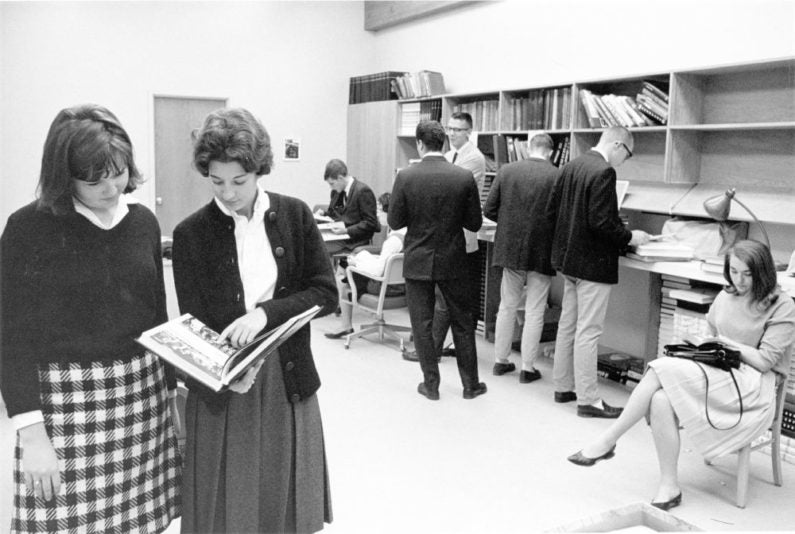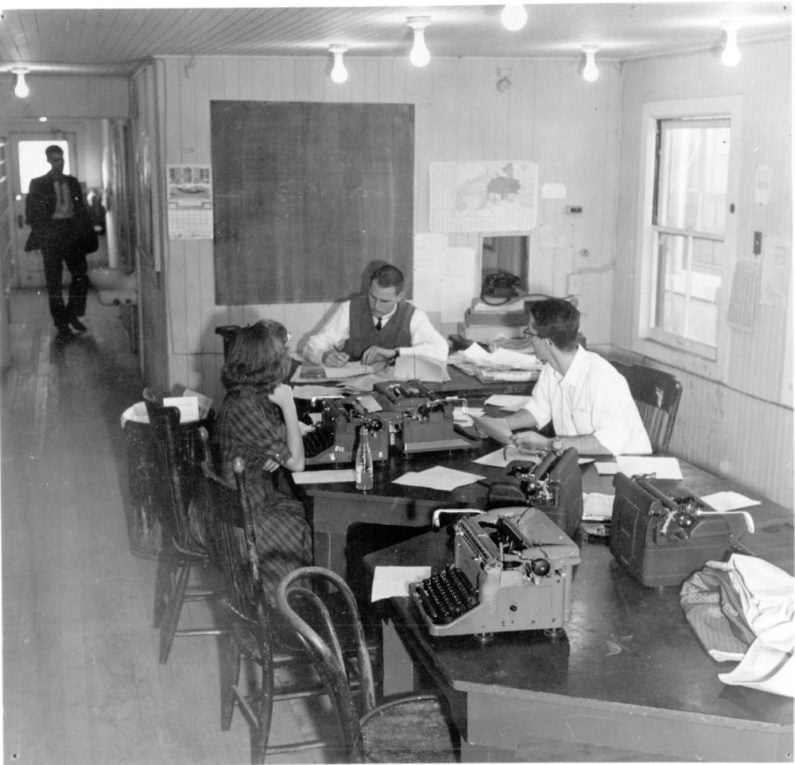The Stanford Daily celebrates 125 years of student involvement
Fall 2017 marked 125 years since the foundation of The Stanford Daily, an independent, student-run paper reporting on the campus and community. Working on the paper helped launch journalism careers and created a community for staffers.
At around 7 p.m. every weekday, about a dozen Stanford undergraduate students gather at the Lorry I. Lokey Stanford Daily Building near Old Union to get started on what many of those students refer to as their other major – writing, editing and producing the upcoming edition of The Stanford Daily. The students often work into the wee hours of the night, until 2 a.m. or even later, to provide the Stanford community with campus and community news.

Stanford’s student-run newspaper has provided a community and a career-starter for 125 years. (Image credit: Special Collections–University Archives)
Those involved with The Daily come from different backgrounds and majors, but share a passion for daily journalism that, for many of them, guides their future careers.
“The joke that we all say a lot is that we majored in The Stanford Daily,” said Ada Statler, an Earth systems senior and current editor-in-chief. “My experiences at The Daily have been a huge contribution to my learning, both in terms of academic topics but also just growing myself as a person.”
During the recently ended fall quarter, the student-run newspaper celebrated its 125th anniversary and its continuing impact on the experience of Stanford students and other community members. The paper covers a broad range of breaking, sports and feature news at Stanford and the nearby communities of Palo Alto, Mountain View, Menlo Park and Atherton.
Statler said she, like many other Stanford freshmen, signed up for several student clubs, including The Daily, during her first fall quarter at the university.
“The Daily was the one thing that stuck,” Statler said. “There was this great sense of community here right from the get-go.”
That sense of camaraderie may stem partly from The Daily’s vast history and culture passed down from one student cohort to the next.
From bulletin board to independent paper

Typewriters have given way to computers, but the late hours and deadline pressure of a daily newspaper are ever present. (Image credit: Special Collections–University Archives)
Founded in 1892, one year after Stanford’s opening, the paper was at first called The Daily Palo Alto and was primarily a collective bulletin board. In 1905, the paper’s name was changed to The Stanford Daily in order to separate it from The Daily Palo Alto Times, a separate publication that operated in the first half of the 20th century. In the 1970s, The Daily formed a nonprofit organization and became an independent news organization, separating from Stanford’s administration and faculty. This gave The Daily freedom to pursue impartial reporting coverage about the university and its news.
Since then, nearly 19,000 issues of The Daily have been published with over 1 million articles, each one of which can be accessed through the paper’s extensive online archive. Altogether, about 200 students help produce the publication each quarter.
Some of the students who have worked at The Daily went on to become notable journalists. The Daily alumni include Business Wire founder Lorry I. Lokey, humor columnist Joel Stein, photographer Art Streiber and former New York Times reporter Philip Taubman, who is now an associate vice president for university affairs at Stanford and serves as secretary of the university Board of Trustees.
Taubman, who graduated from Stanford in 1970, returned to the university after retiring from the New York Times in 2008. Taubman said his involvement with The Daily solidified his decision to pursue journalism as a career. During his time there in the late 1960s, Taubman said he experienced some of the most memorable moments as a reporter, including interviewing Martin Luther King as a freshman.
“The Daily was really the center of my life at Stanford,” Taubman said. “It’s where I spent an inordinate amount of time, neglecting some of my academic responsibilities. But it was kind of an intoxicating experience to be a student journalist at a time of tremendous upheaval at the university.”
Taubman said that the four years he spent at the paper, eventually serving as an editor-in-chief, gave him the basic foundation for writing and reporting that launched his future career. Taubman is currently working on a biography of George Shultz, the former U.S. secretary of state and now a fellow at the Hoover Institution and an advocate for nuclear disarmament.
Juggling deadlines
Fifty years since Taubman first joined The Daily, Stanford students who participate with the paper echo his sentiments about the importance of the newspaper in their academic and personal lives.
“I don’t know what I would have done with myself,” said Statler, after being asked to imagine what her time at Stanford would have been like had The Daily not been around.
The demanding lifestyle of a Daily staffer requires responding to breaking news as it happens and meeting deadlines while juggling classes and exams. Because the news can break at any time, staffers sometimes need to be able to respond and work during holiday breaks. This pressure and responsibility make The Daily stand out from other student clubs, Statler said.
Statler emphasized the gratitude she and other students feel for not just being able to participate in creating an independent newspaper but also for having their own office and building, which opened in 2009. The latter is not something every student group has, she said.
Statler said many Daily staffers refer to their new building as “the house” in daily conversations, which sometimes causes confusion with staffers’ friends who are not aware of the slang term.
“That term shows how important The Daily experience is to a lot of people who are in it,” Statler said. “It’s really inspiring to see Stanford students, who have all of this other stuff on their plate, want to make those community contributions, prioritizing that and really caring that much.”
